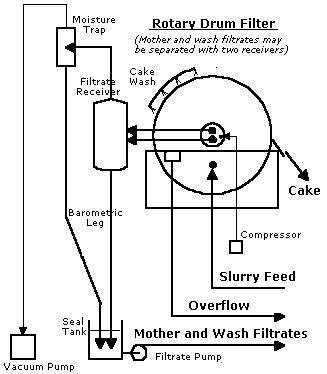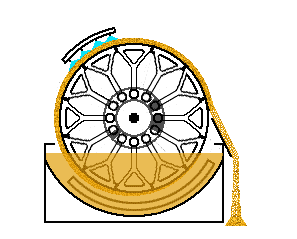Choose the Right Vacuum Pump – Escolha a Bomba de Vácuo Correta
maio 13 Number of View :4527Several devices are available for producing vacuum at a chemical-process plant.
Each has its own advantages and drawbacks. This article from Joe Aliasso was printed in the Chemical Engeeniring Magazine – March 1999.
Click here to download the article
 Clique aqui para fazer o “download” do artigo
Clique aqui para fazer o “download” do artigo
A geração de vácuo em processos químicos pode ser feita por vários tipos de bombas de vácuo.
Cada uma tem seus prós e contras. Leia mais neste artigo de Joe Aliasso que foi publicado na revista Chemical Engineering de Março de 1999.
Vacuum Filtration Designing Data – Filtração a Vácuo/Dados para Projeto
fev 08 Number of View :4914It is unquestionable that the internet came to help. Young engineers are very familiarized with it. Internet is their second skin. You can find whatever you want at the internet.
Well, that is a partial truth. Old paper from old engineers are still in the drawers and where not scanned. Useful information that we used to have from the sales reports, service reports and troubleshooting reports are not in the internet, and sooner or later will be lost forever.
I am reviewing my old papers and found an intersting training one from Nash about vacuum filters, subject of my previous post, and that now will be preserved at the net.
Click here to download the VACUUM-FILTRATION TIPS
Clique aqui para abaixar VACUUM-FILTRATION TIPS
É indiscutível que a internet veio para ajudar. Jovens engenheiros são muito familiarizados com ela. A internet é a sua segunda pele. Você pode encontrar o que quiser na internet.
Bem, isso é uma verdade parcial. Antigos documentos de engenheiros da velha guarda ainda estão nas gavetas e onde não foram digitalizados. Informações úteis que estavamos habituados a ter a partir dos relatórios de vendas, relatórios de serviços e relatórios de correção de problemas, não estão na internet, e mais cedo ou mais tarde estarão perdidas para sempre.
Estou revendo meus documentos antigos e encontrei um interessante artigo de treinamento da Nash sobre filtros a vácuo, tema do meu post anterior, e que agora serão preservados na rede.
Vacuum Pump Maintenance, Step by Step – Manutenção em Bomba de Vácuo, Passo a Passo
nov 04 Number of View :4291These 3 videos from Omel Bombas e Compressores Ltda show step by step how to disassemble and assemble a close coupled liquid ring vacuum pump. Videos have subtitles in English.
embedded by Embedded Video
embedded by Embedded Video
embedded by Embedded Video
Estes 3 vídeos da Omel Bombas e Compressores Ltda, mostram passo a passo como desmontar e montar uma bomba de vácuo de anel líquido, do tipo monobloco. O vídeo é falado em português com legendas em inglês.
Magdeburg Experiment – Experimento de Magdeburg
out 01 Number of View :10903The history of vacuum pumping system engineering begins with Guericke’s experiment at Magdeburg in northern Germany in 1654. Earlier in the century, Galileo Galilei had reported the creation of a partial vacuum formed by withdrawing a piston from a cylinder. Evangelista Torricelli invented the mercury barometer in 1643. The first vacuum pump was invented by Otto von Guericke around 1650. This pump was used in the famous “Magdeburg hemispheres” experiment in which 16 horses were unable to separate two evacuated copper hemispheres.
This text was extracted from the book Process Vacuum System Design & Operation, by James L. Ryans and Daniel L. Roper – McGraw-Hill Book Company, 1986 ISBN 0-07-054355-0 , in my humble opinion, the best book about vacuum process.
You are about to see a reenactment of this experiment staged by the Technical University of Ilmenau and a the recreation made by Russell Zeid, educator at the Ontario Science Centre .
embedded by Embedded Video
embedded by Embedded Video
A história da engenharia de sistemas de vácuo começa com o experimento de Guericke em Magdeburg, na Alemanha do Norte em 1654. No começo do século, Galileu Galilei tinha relatado a criação de um vácuo parcial obtido mediante a retirada de um pistão de um cilindro. Evangelista Torricelli inventou o barômetro de mercúrio em 1643. A bomba de vácuo foi inventada por Otto von Guericke em 1650. Esta bomba foi usada no famoso experimento dos “hemisférios de Magdeburgo”, no qual 16 cavalos foram incapazes de separar os dois hemisférios de cobre previamente evacuados.
Este texto foi extraído do livro Process Vacuum System Design & Operation, de James L. Ryan e Daniel L. Roper – McGraw-Hill Book Company, 1986 ISBN 0-07-054355-0, na minha humilde opinião, o melhor livro sobre vácuo.
Você está prestes a ver uma reconstituição deste experimento organizado pela Universidade Técnica de Ilmenau e uma recriação do feito por Russell Zeid, educador no Ontario Science Centre.




